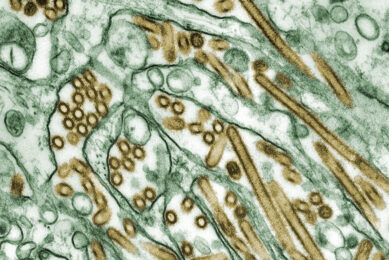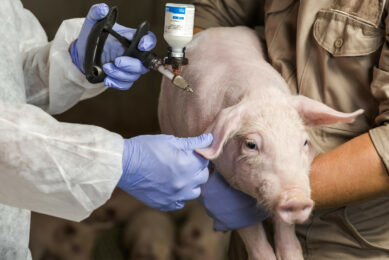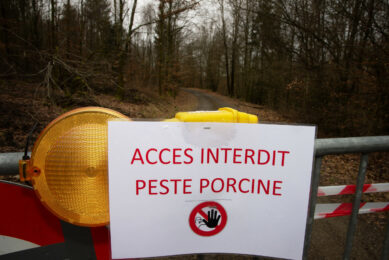IPVS Congress: How pig vets can do a better job
![Mucky, the mascotte of the 2016 IPVS Congress. [Photo: Vincent ter Beek, RBI]](https://www.pigprogress.net/app/uploads/2021/04/005_427_rb-image-2818052-848x565.jpeg)
No farm is the same and no pig is the same. More and more veterinarians are realising that to become better pig vets, an increasingly more targeted approach is needed. Precise data and an open, critical mind are indispensable tools to get there.
EXPERT
For me, one of the most impressive presentations at this year’s International Pig Veterinary Society (IPVS) Congress, held June 7-10, 2016, in Dublin, Ireland, was a short, personal one by the British veterinarian Dr John Carr, on the very last day. In a speech paving the way for The Great Debate, he frankly spoke of his own doubts.
Porcine Epidemic Diarrhoea in Ukraine
Early 2015, it was him who, together with a team of veterinarians, reported about the discovery of highly virulent Porcine Epidemic Diarrhoea (PED) on a swine farm in Ukraine. He realised that what he had discovered was important and hitherto unknown knowledge – and at the same time, he said, there was a shimmer of doubt.
He had been travelling from Asia before coming to Ukraine. What if…what if… it had been him who had brought the virus into the farm in the first place? After all he had been there a few days before it started.
Are we critical enough?
Dr Carr told that soon it was proven that he had nothing to do with it, but the point he wished to make was clear: had he been critical enough of his own behaviour? Had he been careful enough? To illustrate this point he gave another example from his own career. How often, in years long gone by, had he not just chucked dirty boots in the back of the car after a farm visit, and worn them again on a next visit? And whether his audience recognised this.
The audience replied with a nervous giggle.
Clearly he had struck a nerve here. His message: no thorough advice, no detailed health plan, no antibiotics and no vaccines are going to pay off on a farm if the veterinarian has not set the right example.
Being critical to standard practices
The Dublin congress, which was organised in conjunction with the European Symposium for Porcine Health Management (ESPHM) and which attracted over 3,500 vets from 71 countries worldwide, had some excellent other examples of veterinarians that had taken a moment to reflect at a certain point in their daily duties. These vets were confronted with a health problem on a farm, and instead of accepting its occurrence and treating it, they stepped back and wondered – what management practices could have caused these?

Dr Tijs Tobias, from Utrecht University, the Netherlands, presented a case of a farm with a slight increase in the number of gilts with a return to oestrus. After an analysis using data on feed intake and reproduction he and his colleagues concluded that this was probably the result of early embryonic death, likely caused by feed deprivation, as a result of additional trough feeding in the gilt phase.
No conditioning of feeding station use
In this phase, the gilts should have been trained how to use Electronic Sow Feeding stations, but additional troughs with feed had been supplied to ensure proper feed intake. Thus the gilts had never been conditioned to use the feeding stations – only to go through them to access the trough. When it really mattered, the animals waited for a trough that did not come, did not consume sufficiently, resulting in an animal health problem.

The suggested solution: stop providing additional troughs of feed to the gilts during their training – and the health problem would disappear.
Nematodes on a US pig farm
Similarly, Tom Gillespie, of Rensselaer Swine Services, in Indiana, United States, spoke of recurring nematode problems in a sow farm he was involved with, Ascaris suum was found regularly. When studying the phenomenon, he and his team suspected that apart from replacement gilts, lagoon effluent was also a source of the worm infection. Trials confirmed this. “The finding of viable Ascaris eggs in lagoon effluent is noteworthy,” he wrote.
When attempting to film the manure flushing process underneath the pig house, he observed that the fluid in the manure pit temporarily flushed above-slat level, creating a direct risk for contamination. He shared footage made by a mobile phone.
The solution would be simple – adjust the flushing process.
Precision farming moves into animal health
One other way to help veterinarians do their job better is an animal health version of precision farming. In agriculture, ‘precision’ is often used when referring to targeted crop or animal management.
In pig production, one could think of specific feed rations for specific age groups or stage of weaning. And the more that can be measured about the animals’ performance on-farm, the more sow breeders and pig producers know, and the more precise pig management can get. Using so-called ‘Big Data’, on one hand, the animals perform better, on the other, it’s sustainable because more can be achieved with less.

Big Data for veterinarians
If Big Data and precision farming can be applied to the daily routine of pig producers, then why not for veterinarians? Following the line of thought of using Big Data, both Hipra and MSD Animal Health proudly showcased in Dublin their next generation of intra-dermal, needle free vaccination devices, which can store and communicate vaccination results to an app.
This way a much better insight can be acquired about the vaccination process of pigs, helping to substantially improve the process.
Needle-free vaccinating
Needle-free vaccinating is better for internal biosecurity reasons as well – and that brings me back to Dr Carr I spoke about in the beginning of this contribution.

In his personal and thoughtful speech, he also referred to another anecdote – the use of needles when vaccinating. Years ago, he said, he used to inject maybe 100 pigs with one needle. Not good, he knows now, and he has long stopped doing it. He also enquired whether the audience recognised the practice.
Again, there was that nervous giggle.











